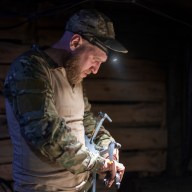julia dimon/for metro Toronto
Louisiana’s West Pearl River is home to gnarled cypress trees, swollen buttress roots and, some say, the legendary Honey Island Swamp Monster.
Dr. Wagner’s Honey Island Swamp Tour
El Whappo is one of the biggest alligators seen in Louisiana’s West Pearl River.
His name is El Whappo. He’s 70 years old, 13 feet long and he’s one of the biggest alligators seen in Louisiana’s West Pearl River.
Our tour group found the monster reptile lounging along the sandy river bank, soaking up the afternoon sun. As our motorboat approached for a better look, the alligator turned its snout, slid from the shore and floated towards us.
This was Dr. Wagner’s Honey Island Swamp Tour, a two-hour guided boat ride through Louisiana’s wetlands. Open since 1984, the tour focuses on the natural environment and its indigenous wildlife: from tiny turtles to moss-covered cypress trees, slimy green duck weed (a staple in many swamp dwellers’ diets), to blue herons the size of pterodactyls.
Alligators are some of the most interesting animals to spot. Sure they’re less aggressive than crocodiles but alligators do have some of the strongest jaws in the animal kingdom. We learn that gators don’t chew their prey, they just swallow them whole. If the prey is too big, the alligator will tear off chunks of flesh and save it for later.
“Alligator attacks are rare but they do sometimes occur, so keep hands, feet and cameras inside of the boat at all times,” our guide reminded us.
He launched a white marshmallow into the water, just inches from the boat. Bobbing like a wine cork, the marshmallow was doomed. El Whappo swam toward it, opened up his jaws and wrapped a set of razor sharp teeth around the sugary treat.
Submerged, with only their eye-balls skimming the water’s surface, it’s often hard to tell how big some alligators actually are.
Our guide shared a quick tip. A gator’s size can be determined by the length of their snouts. Every inch of snout corresponds to every foot in body length. Using this equation, El Whappo sure was a big boy.
Several marshmallows later, we left El Whappo and cruised down river, through rootbeer colored waters to a maze of narrow waterways.
Though the eye of Hurricane Katrina did pass over the area, there was very little damage to the 80,000 acres of swamp land.
The dense foliage, swollen buttresses roots and gnarled trees are still in tact but many oak trees didn’t survive the storm.
As we puttered through the swamps, the thick Caladenia (four leaf clover look-alikes) and cypress knees (tree stump roots sticking out of the water) threatened to clog our outboard motor. Not sure if it was the flora, the threat of poisonous snakes or the alligator infested waters but there was definitely something spooky about Louisiana’s swamp lands. Something mysterious and unknown lurking in the shadows…
As legend goes, there have been eye-witness reports of a seven-foot-tall Bigfoot type creature that lives in the area.
They call it the Honey Island swamp monster. It’s been described as: “half mammal, half reptile, all man-eater.” Of course, no one can prove it actually exists but there are still some locals who dare not enter the swamps alone.
Outside of the swamps, along the river’s edge, there were fishing camps and high-end homes where locals go to unwind on weekends.
While some were immaculate with manicured lawns and screened-in swimming pools, others were dilapidated shacks, straight out of a horror flick.
Though our tour group didn’t spot the swamp monster, we did learn a few things: Louisiana’s wetlands are vulnerable, oak trees don’t survive hurricanes and alligators really like marshmallows.
Julia Dimon is editor of The Travel Junkie, an online magazine for independent travellers. She can be reached at www.thetraveljunkie.ca.
| Julia’s tips |
|
















